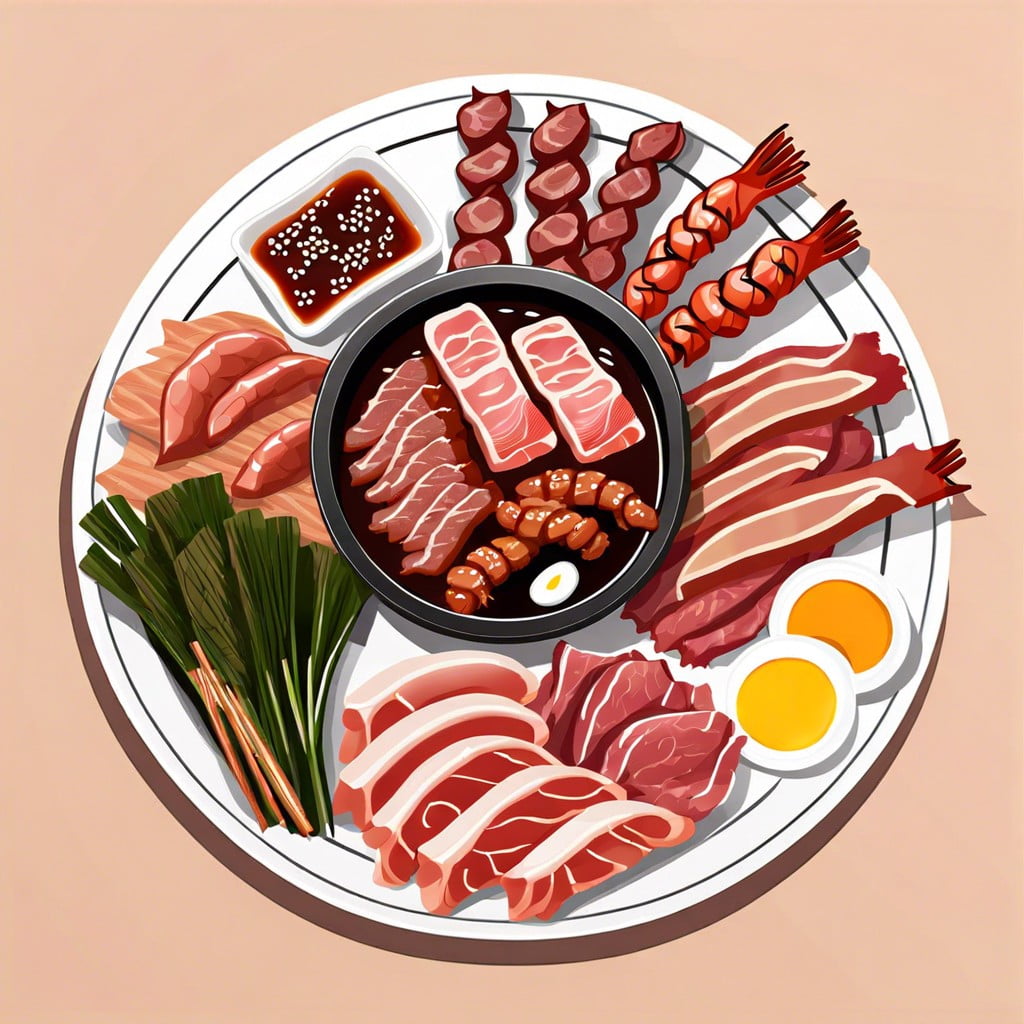This article breaks down the factors affecting the price of Korean BBQ and how they weigh in on your bill.
Key takeaways:
- Korean BBQ dishes: bulgogi, galbi, dak galbi, samgyeopsal, tofu and veggies
- Cost of dining: varies based on options, location, meat selection
- Factors affecting cost: location, menu selection, meat quality, AYCE options, beverages and sides, dining experience
- Tips for saving money: share with friends, take advantage of lunch specials, order wisely, maximize complimentary sides, be mindful of beverages, look for discounts
Popular Korean BBQ Dishes

Tantalizing your taste buds, bulgogi leads the charge with its marinated beef slices, often ribeye, sizzling and soaking up a sweet and savory sauce. Next up is galbi, the pork sibling to bulgogi, featuring meaty ribs that get their flavor kick from a soak in garlic, soy, and sugar marinade.
Dak galbi brings a little poultry play to the table, marinated chicken fired up with a spicy kick of gochujang, Korea’s answer to a ‘bring-the-heat’ sauce. If you’re flirting with the idea of something less conventional, samgyeopsal—uncured pork belly in all its unadulterated glory—is a sure-fire palate pleaser, especially when grilled to crispy perfection.
For those riding the no-meat wave, do not fret. Tofu and a parade of veggies often find their way to the grill, marinated in the same mouthwatering flavors, proving that you don’t need meat to partake in this culinary fiesta.
Each dish dances on the grill right before your eyes, forging a carnivorous carnival that elevates the feasting experience beyond average backyard barbeque shenanigans. As you grab your tongs and dive into this interactive cooking affair, remember, it’s not just a meal, it’s a flavor-filled journey lettered in bold Korean characters.
Cost of Dining At a Korean BBQ Restaurant
The price tag on a Korean BBQ feast can vary as wildly as the spice level in kimchi. Expect to pay more if you’re eyeing a spot with grill-your-own options, where premium meats like wagyu beef sizzle on your table’s grill. A set menu per person could run anywhere from $15 to $50, based on the meats and side dishes served.
Location is another price pivot. In cosmopolitan centers, anticipate digging deeper into your wallet. Tourist hotspots also tend to inflate their rates. There’s overhead to consider, too; fancier digs with sleek decor and high-tech grills often pass on the cost in their pricing.
The eatery’s meat selection is the central character in this financial story. Selecting prime cuts like beef short ribs will bump up the bill, whereas chicken or pork belly often prove more wallet-friendly. And remember, side dishes—called banchan—are typically refilled at no extra charge, so you can indulge in those spicy, tangy delights to pad your meal without padding the expense.
Good news for bold, solo diners: some joints offer individual portions. But the common thread is the communal experience, pitching in with pals to order a combo platter that can skew costs downwards thanks to the share factor.
In short, how much you shell out rests on various elements from meat quality to location. Striking a balance between thrift and thrill requires a savvy approach to selection. Keep these variables in mind and you might just finesse your way into a budget-friendly yet lip-smacking meal.
Factors That Affect the Cost of Korean BBQ
The location of a restaurant plays a significant role in pricing. Eateries in bustling city centers or upscale neighborhoods often have steeper costs due to higher rent and operational expenses.
Menu selection also impacts cost. Traditional favorites like bulgogi may be more pocket-friendly, while premium items such as galbi or wagyu beef will nudge the bill upward.
Meat quality is a factor not to be overlooked. Higher grades of meat, such as USDA Prime or Korean Hanwoo beef, will surely increase the cost per serving.
All-you-can-eat (AYCE) options can offer value for hearty appetites, but remember that price points vary and may depend on the variety and quality of meat available.
Beverages and side dishes, known as banchan, can add up. While banchan is often complimentary, refills or premium sides, along with alcoholic beverages like soju or beer, will swell the tab.
Lastly, the dining experience itself—not just the food but also the ambiance and service quality—can influence the cost. A place with tableside grilling service and sleek decor might charge more, reflecting the elevated dining experience provided.
Tips for Saving Money At a Korean BBQ Restaurant
Eating at a Korean BBQ spot doesn’t have to burn a hole in your wallet. Sharing is caring—and cost-effective. Rally a group of friends to get more bang for your buck. Diverse selections can be enjoyed and shared, slashing per person costs.
Timing is everything. Hit up lunch specials or happy hour deals. Many restaurants offer the same sizzling selections for a fraction of the dinner price during these times.
Eyes bigger than your stomach? Order wisely. Starting with a few plates and adding as needed avoids waste and keeps the bill lean.
Save on sides. Banchan, the small side dishes, are often refillable and complimentary. Make the most of these tasty bites to supplement your meal without adding to the cost.
Beware of the beverage bandwagon. Drinks can inflate your bill quicker than a balloon at a birthday bash. Stick with water or opt for sharing a communal beverage to keep things light on your wallet.
Break out the BBQ detective skills. Scout online or in local publications for vouchers or discounts at Korean BBQ joints. A little research can lead to delicious deals.
Remember, the art of Korean BBQ isn’t just in the grilling—it’s in savvy dining too.

